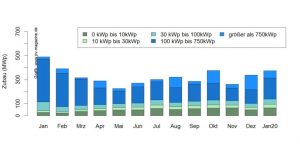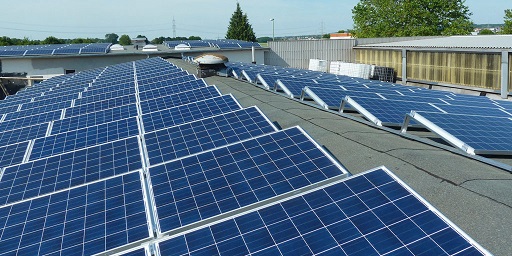German federal electricity network agency the Bundesnetzagentur has reported 374.7 MW of new PV installations were registered in the country in January. The figure compares to around 399 MW in December and 579 MW in January last year.
Of the new capacity, around 309 MW consisted of projects developed outside the tender scheme which applies to facilities with generation capacities of 750 kW-10 MW. Of that non-tender capacity, 74.4 MW was supplied by ground-mounted plants.
Under capacity-linked automatic feed-in tariff (FIT) reduction rules, the FIT has fallen 1.4% this month. The same reduction applies to the tariff paid to owners of systems with a generation capacity of more than 100 kW, who must contract to supply power directly to energy off-takers under ‘direct marketing’.
FITs for rooftop solar systems range from €0.0731-0.0958/kWh, depending on system size. Other systems with a generation capacity of up to 100 kWh, such as motorway sound barriers, receive €0.066. Direct marketing installations receive €0.0004 on top of the fixed FIT tariff.
Germany reached a total 49,425 MW of subsidized solar generation capacity at the end of January. That cumulative figure was revised down 358 MW from the 49,783 MW given out by the Bundesnetzagentur at the end of the year.


The network agency said: “New knowledge of the installed capacity, through the introduction of the market master data register, makes it necessary to revise the methodology for determining the total installed capacity of solar systems in accordance with the German renewable energy law [EEG]. The new network master data register of the Bundesnetzagentur has been in operation since January 31, 2019 and, in contrast to the old registers, also enables, among other things, the recording of operator changes, implementation and shutdown of systems. As a result, the total was revised based on the latest analysis results from the Bundesnetzagentur on the operating status and installed capacity.”
According to the revised data, solar capacity growth in Germany last year was slightly lower than the 3.94 GW stated at the end of the year, instead coming in at 3.87 GW.
That at least gives developers 70 MW more wiggle room before the 52 GW figure is reached and, under the provisions of the EEG, all subsidy payments for new systems with a capacity of up to 750 kW come to an end. The government in September announced it intended to lift the 52 GW ceiling but nothing has yet been legislated in relation to that pledge, announced as part of the nation’s Climate Change Act.






